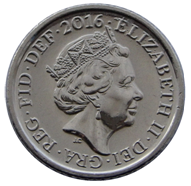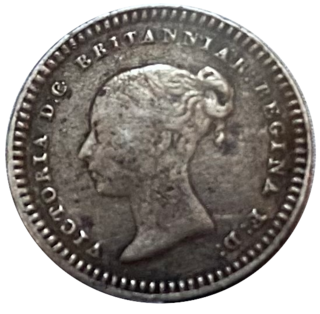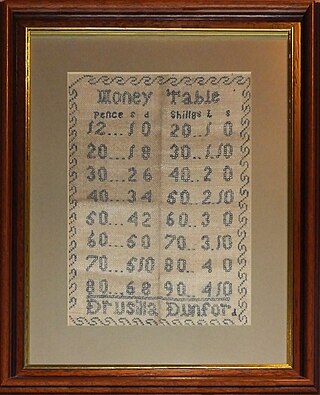
The standard circulating coinage of the United Kingdom, British Crown Dependencies and British Overseas Territories is denominated in pennies and pounds sterling, and ranges in value from one penny sterling to two pounds. Since decimalisation, on 15 February 1971, the pound has been divided into 100 (new) pence. Before decimalisation, twelve pence made a shilling, and twenty shillings made a pound.

The British decimal five pence coin is a unit of currency equalling five one-hundredths of a pound sterling. Its obverse has featured the profile of Queen Elizabeth II since the coin’s introduction on 23 April 1968, replacing the shilling in preparation for decimalisation in 1971. It remained the same size as the one shilling coin, which also remained legal tender, until a smaller version was introduced in June 1990 with the older coins being withdrawn on 31 December 1990. Four different portraits of the Queen have been used, with the latest design by Jody Clark being introduced in 2015. The second and current reverse, featuring a segment of the Royal Shield, was introduced in 2008.

The British half farthing was a coin worth 1/1,920 of a pound, 1/96 of a shilling, or 1/8 of a penny sterling. It was minted in copper for use in Ceylon, but in 1842 was also declared legal tender in the United Kingdom. Two different obverses were used. Like all British coinage, it bore the portrait of the monarch on the obverse.

The British third farthing was a coin worth 1/2880 of a pound, 1/144 of a shilling, or 1/12 of a penny sterling. It was produced in various years between 1827 and 1913.

The penny of Great Britain and the United Kingdom from 1714 to 1901, the period in which the House of Hanover reigned, saw the transformation of the penny from a little-used small silver coin to the bronze piece recognisable to modern-day Britons. All bear the portrait of the monarch on the obverse; copper and bronze pennies have a depiction of Britannia, the female personification of Britain, on the reverse.

The British florin, or two-shilling piece was a denomination of sterling coinage worth 1/10 of one pound, or 24 pence. It was issued from 1849 until 1967, with a final issue for collectors dated 1970. It was the last coin circulating immediately prior to decimalisation to be demonetised, in 1993, having for a quarter of a century circulated alongside the ten-pence piece, identical in specifications and value.

The British three halfpence was a coin worth 1/160 of one pound or 1/8 of one shilling sterling. It was produced for circulation in the British colonies, mainly in Ceylon and the West Indies in each year between 1834 and 1843, and also in 1860 and 1862. Proof coins were also produced in 1870.

The British pre-decimal halfpenny, , historically also known as the obol and once abbreviated ob., was a coin worth 1/480 of one pound, 1/24 of one shilling, or 1/2 of one penny sterling. Originally the halfpenny was minted in copper, but after 1860 it was minted in bronze. In the run-up to decimalisation it ceased to be legal tender from 31 July 1969. The halfpenny featured two different designs on its reverse during its years in circulation. From 1672 until 1936 the image of Britannia appeared on the reverse, and from 1937 onwards the image of the Golden Hind appeared. Like all British coinage, it bore the portrait of the monarch on the obverse.

The British farthing historically abbreviated qua., was a coin worth 1/960 of one pound, 1/48 of one shilling, or 1/4 of one penny sterling. It was minted in copper and later in bronze, and replaced the earlier English farthings.

The British threepence (3d) piece, usually simply known as a threepence, thruppence, or thruppenny bit, was a coin worth 1/80 of one pound or 1/4 of one shilling sterling. It was used in the United Kingdom, and earlier in Great Britain and England. Similar denominations were later used throughout the British Empire and Commonwealth countries, notably in Australia, New Zealand and South Africa.

The British crown was a coin worth 1/4 of one pound, 5 shillings, or 60 pence. The crown was first issued during the reign of Edward VI, as part of the sterling coinage of the Kingdom of England.

The groat is the traditional name of a defunct English and Irish silver coin worth four pence, and also a Scottish coin which was originally worth fourpence, with later issues being valued at eightpence and one shilling.

£sd is the popular name for the pre-decimal currencies once common throughout Europe, especially in the British Isles and hence in several countries of the British Empire and subsequently the Commonwealth. The abbreviation originates from the Latin currency denominations librae, solidi, and denarii. In the United Kingdom, these were referred to as pounds, shillings, and pence.
The British farthing was a British coin worth a quarter of an old penny. It ceased to be struck after 1956 and was demonetised from 1 January 1961.

The British sixpence piece, sometimes known as a tanner or sixpenny bit, was a coin worth 1/40 of one pound or 1/2 of one shilling sterling. It was first minted in 1551, during the reign of Edward VI, and circulated until 1980. Following decimalisation in 1971 it had a value of 2+1/2 new pence. The coin was made from silver from its introduction in 1551 until 1947, and thereafter in cupronickel.
The threepence or threepenny bit was a denomination of currency used by various jurisdictions in England, Ireland, Scotland and Wales, valued at 1/80 of a pound or ¼ of a shilling until decimalisation of the pound sterling and Irish pound in 1971. It was also used in some parts of the British Empire, notably Australia, New Zealand and South Africa.

The British shilling was a unit of currency that equalled 1/20 of one pound, or twelve pence sterling. It was first minted in the reign of Henry VII as the testoon, and became known as the shilling, from the Old English scilling, sometime in the mid-16th century. It circulated until 1990. The word bob was sometimes used for a monetary value of several shillings, e.g. "ten-bob note". Following decimalisation on 15 February 1971 the coin had a value of five new pence, and a new coin of the same value but labelled as "five new pence" or "five pence" was minted with the same size as the shilling until 1990, after which the shilling no longer remained legal tender. It was made from silver from its introduction in or around 1503 until 1946, and thereafter in cupronickel.
The English shilling was a silver coin of the Kingdom of England, when first introduced known as the testoon. It remained in circulation until it became the British shilling as the result of the Union of England and Scotland to form the Kingdom of Great Britain in 1707.

The double sovereign is a gold coin of the United Kingdom, with a nominal value of 2 pounds or 40 shillings sterling.

Jubilee coinage or Jubilee head coinage are British coins with an obverse featuring a depiction of Queen Victoria by Joseph Edgar Boehm. The design was placed on the silver and gold circulating coinage beginning in 1887, and on the Maundy coinage beginning in 1888. The depiction of Victoria wearing a crown that was seen as too small was widely mocked, and was replaced in 1893. The series saw the entire issuance of the double florin (1887–1890) and, in 1888, the last issue for circulation of the groat, or fourpence piece, although it was intended for use in British Guiana. No bronze coins were struck with the Jubilee design.


















